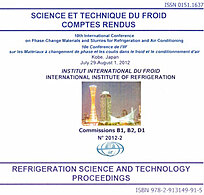
Document IIF
Études expérimentales de la densité thermique d'un coulis de paraffine et d'hydrate gazeux.
Experimental studies of the heat density of paraffin and gas hydrate slurry.
Numéro : pap. 072
Auteurs : YOUSSEF Z., DELAHAYE A., FOURNAISON L.
Résumé
Due to the high increase of energy consumption and after Montreal and Kyoto protocols, it has been necessary to reduce power consumption and the propagation of the refrigerants in the atmosphere by improving the performances of the refrigerating machines. In this context, the use of Thermal Energy Storage (TES) techniques could be an interesting solution. Classical secondary refrigerants, such as water and glycol aqueous solutions, are single phase fluids limited by their small cold carrying capacity. Moreover, secondary refrigerants need the use of addi-tional pumps leading to high thermodynamic irreversibilities. In order to combine a more efficient secondary loop and fluids with higher energy storage capacity, a phase change material (PCM) slur-ry could be used as secondary refrigerant. In such systems, energy is stored mainly during a phase change process of the storage material and a carrier fluid should be used as a continuous phase. The obtained system is called Phase Change Slurry (PCS). PCS has a higher energy density than single-phase secondary refrigerants due to both sensible and latent heat capacities of the materials. In the present work, three types of PCS systems were investigated: CO2 hydrate slurry, paraffin dispersion and hydrate-paraffin slurry. CO2 hydrate slurry was already studied at Irstea (France) and it was found that its dissociation enthalpy (500 kJ.kg-1(water)) was higher than that of ice (333 kJ/kg). Studies on paraffins latent heat enthalpy were already accomplished only under atmospheric pres-sure at the Fraunhofer institute (Germany) and the total emulsion enthalpy was largely higher than then sensible heat of pure water. It was also shown that paraffin dispersions have good flowing ca-pacities. The purpose of this work is to combine CO2 hydrate and paraffin dispersion systems in order to reach a PCS system that combines the advantages in terms of melting enthalpy and flowing capacities. Therefore, a DTA device was used in which the phase change temperatures and the cor-responding enthalpies for many PCS systems were measured. The best system must verify some requirements: stability over a large period of time, high storage density (higher than ice), good flowing capacities and phase transformation between 0 and 20°C under moderate pressure.
Documents disponibles
Format PDF
Pages : 7 p.
Disponible
Prix public
20 €
Prix membre*
Gratuit
* meilleur tarif applicable selon le type d'adhésion (voir le détail des avantages des adhésions individuelles et collectives)
Détails
- Titre original : Experimental studies of the heat density of paraffin and gas hydrate slurry.
- Identifiant de la fiche : 30005078
- Langues : Anglais
- Source : 10th International Conference on Phase-Change Materials and Slurries for Refrigeration and Air Conditioning. Proceedings: Kobe, Japan, July 29-August 1, 2012.
- Date d'édition : 01/07/2012
Liens
Voir d'autres communications du même compte rendu (46)
Voir le compte rendu de la conférence
Indexation
-
Thèmes :
Mesures thermodynamiques;
Frigoporteurs diphasiques (MCP, coulis de glace…) - Mots-clés : Paraffine; Gaz; Mélange; Matériau; Hydrate; Experimentation; Changement de phase; CO2
-
Viscosity characteristics of slurries containin...
- Auteurs : HASHIMOTO S., KAWAMURA K.
- Date : 01/07/2012
- Langues : Anglais
- Source : 10th International Conference on Phase-Change Materials and Slurries for Refrigeration and Air Conditioning. Proceedings: Kobe, Japan, July 29-August 1, 2012.
- Formats : PDF
Voir la fiche
-
Thermophysical properties of phase change emuls...
- Auteurs : MORIMOTO T., TOGASHI K., KUMANO H.
- Date : 16/08/2015
- Langues : Anglais
- Source : Proceedings of the 24th IIR International Congress of Refrigeration: Yokohama, Japan, August 16-22, 2015.
- Formats : PDF
Voir la fiche
-
Energy study of CO2 hydrate slurries formation ...
- Auteurs : OIGNET J., DELAHAYE A., DUFOUR T., et al.
- Date : 16/08/2015
- Langues : Anglais
- Source : Proceedings of the 24th IIR International Congress of Refrigeration: Yokohama, Japan, August 16-22, 2015.
- Formats : PDF
Voir la fiche
-
A new formation kinetics study method of TBPB a...
- Auteurs : CLAIN P., OSSWALD V., SPIGA O., et al.
- Date : 16/08/2015
- Langues : Anglais
- Source : Proceedings of the 24th IIR International Congress of Refrigeration: Yokohama, Japan, August 16-22, 2015.
- Formats : PDF
Voir la fiche
-
Solidification heat transfer characteristics of...
- Auteurs : SUZUKI H., FUJII M., FUDABA T., et al.
- Date : 01/07/2012
- Langues : Anglais
- Source : 10th International Conference on Phase-Change Materials and Slurries for Refrigeration and Air Conditioning. Proceedings: Kobe, Japan, July 29-August 1, 2012.
- Formats : PDF
Voir la fiche
